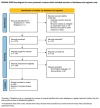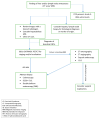Multidisciplinary Approach to the Diagnosis of Occult Primary Neuroendocrine Neoplasm: A Clinical Challenge
- PMID: 37685605
- PMCID: PMC10488469
- DOI: 10.3390/jcm12175537
Multidisciplinary Approach to the Diagnosis of Occult Primary Neuroendocrine Neoplasm: A Clinical Challenge
Abstract
Approximately 11% to 14% of subjects with neuroendocrine neoplasms (NENs) have metastatic lesions with unknown primary origin (UPO), with the majority of UPO-NENs found in the small bowel. Herein, we assessed the available literature on UPO-NENs, focusing on clinical presentation and diagnostic techniques to identify the primary site. The identification of the primary tumor is important as it affects the prognosis; however, the clinical presentation can be non-specific in non-functioning forms. In the presence of metastatic disease, the histological sample is fundamental to obtain immunohistochemical markers that might orientate the clinician in the search for the primary tumor through radiology, functional imaging and endoscopic techniques. In summary, multidisciplinary management plays a key role in UPO-NENs, even more than in other NENs. Molecular biology and gene-expression profiling represent areas of great interest which might be developed in the near future for both the diagnosis and the treatment of these neoplasms.
Keywords: capsule endoscopy; diagnosis; double-balloon enteroscopy; immunohistochemistry; molecular biology; neuroendocrine neoplasms; treatment; ultrasound endoscopy; unknown primary tumor.
Conflict of interest statement
The authors declare no conflict of interest.
Figures




References
-
- Yao J.C., Hassan M., Phan A., Dagohoy C., Leary C., Abdalla J.E.M.K., Fleming J.B., Vauthey J.-N., Rashid A., Evans D.B. One hundred years after “carcinoid”: Epidemiology of and prognostic factors for neuroendocrine tumors in 35,825 cases in the United States. J. Clin. Oncol. 2008;26:3063–3072. doi: 10.1200/JCO.2007.15.4377. - DOI - PubMed
Publication types
LinkOut - more resources
Full Text Sources

